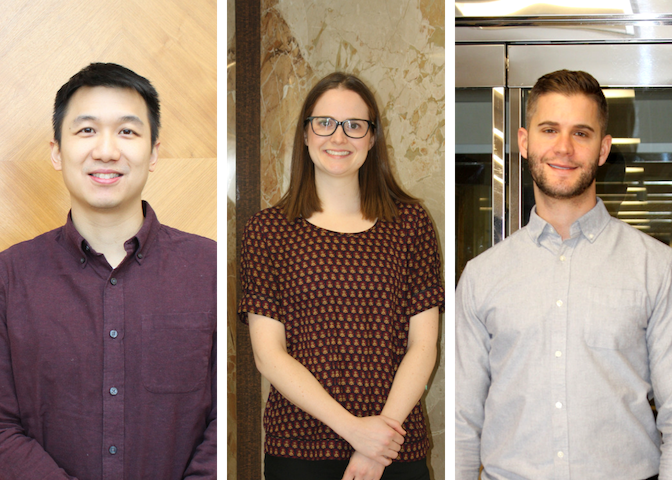A career in public health? DLSPH students set to share emerging research innovation at U of T Health Sciences Fair
May 1/2019
By Rebecca Biason, IHPME
On June 1 at the U of T Health Sciences Fair, part of the University’s Alumni Reunion, three students from the Dalla Lana School of Public Health will be showing high school students and their parents what a career in public health and health systems research could look like. From ground-breaking research opportunities, and a chance to influence changes in our health system, to the way we manage chronic and infectious diseases, these three students will be engaging high-schoolers in some interactive hands-on learning.
“I wanted to put a real-life spin on what I was studying,” said Ryan Ng, an epidemiology PhD candidate, whose dissertation work focuses on the development and validation of the Chronic Disease population Risk Tool (CDPoRT).

(Left to right) Ryan Ng, Maaike deVries and Patrick Ware,.
Ng will be showing kids how this online calculation tool works and how it can predict new cases or incidence of diabetes, CVD, lung cancer and chronic obstructive pulmonary disease in Ontario and Manitoba.
“Using this calculator, anyone can put in their baseline indicator like age, sex, smoking habits, dietary patterns and physical activity. Users can then get their predictive risks for one of those diseases in the next ten years,” said Ng.
Those attending the health sciences fair will be able to test out the tool for themselves or a group of people they know and see what their chances of getting one of these diseases might be, illustrating how this kind of public health prognostic model can be used to influence public health and decision makers.
“It’s also a way to show individuals why you shouldn’t smoke, and why you should drink in moderation,” adds Ng.
Institute of Health Policy, Management and Evaluation (IHPME) PhD candidate Patrick Ware will also be sharing insights into how digital tools can be used to improve health care. His doctoral research centers around evaluating and studying the implementation of telemonitoring systems, like Medly, which uses a mobile application to help heart failure patients manage their condition.
Supplied with a weight scale and blood pressure cuff, patients can use this remote monitoring system to take daily readings of their heart rate, blood pressure and other symptoms each morning.
“One of the main distinguishing factors of this app is its algorithm,” said Ware, “it provides patients with real-time self-management feedback once they’ve recorded their measurements, and also alerts clinicians when something is wrong so that they can follow-up with the patient.”
Fair attendees will be able to see this algorithm in action and learn from Ware about why these types of systems are important in helping to reduce costs in our health system and keeping patients out of emergency rooms.
“Unlike other consumer-based apps, Medly is an entire program that involves bringing together patients and clinicians in order for it to work together effectively. Some of the challenges to scaling up these kinds of programs and integrating them within existing health services relate to physician work-flow and compensation,” said Ware.
This kind of complex and multi-layered way in which our health system functions, particularly in hospitals, is something Maaike deVries is also planning to tackle with high-schoolers by sharing her important research into medication management in hospitals.
deVries, who is also a PhD student at IHPME, looks at how medications are kept secure and accounted for, an important area of research following on the heels of the opioid crisis and the concern around medications being lost or taken outside of a hospital setting.
“There have been some examples we have found where medications could be physically stolen from the hospital and the mechanisms to document are lacking or could be forged so that the loss would go undetected. For instance, a pharmacy technician in hospital could designate a medication as expired even if it was not, and then take the medication instead of sending it to a reverse distributor for disposal,” said deVries.
She has been observing hospital medication use processes that involve the use of technologies such as barcoding, automated dispensing cabinets, electronic medical records and more.
“Not every hospital has the same process. A nurse could be asked to witness the stocking of an automated dispensing cabinet on the unit, and sometimes they count for them self the number of medication being added to the cabinet, and sometimes, because we are human and busy, they will just agree with the pharmacy technician’s first count,” said deVries.
She is hoping to share with young people the different ways to approach researching hospital safety issues in healthcare by looking at the way the whole system interacts (people, technologies, environments). And to also realize that many of the issues in healthcare that arise are more about the environment they work in than the individual actions of people themselves.
“It’s really about how the system works together to help keep people healthy and able to access the care or medications they need,” said deVries.
Interested in attending the U of T Health Sciences Fair? Register for June 1
U of T’s Alumni Reunion has a slew of events this year. See a list of DLSPH Alumni Reunion events here